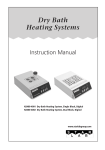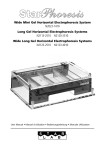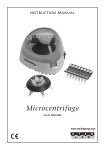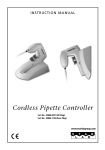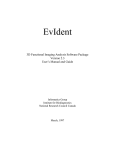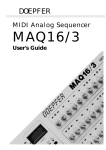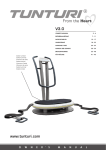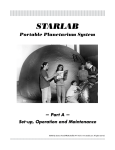Download Rotator User Manual.indd - Ecologie Microbienne Lyon
Transcript
INSTRUCTION MANUAL BEDIENUNGSANLEITUNG MANUEL D’UTILISATION MANUALE D’ISTRUZIONI Rotator–Mixer RM Multi-1 N2400-5000 www.starlabgroup.com CE MARKING The CE marking affixed to the equipment indicates that the STARLAB Rotator–Mixer RM Multi-1 Cat. No. N2400-5000 meets the requirements of the following directives: ELECTROMAGNETIC COMPATIBILITY Council Directive 89/336/EEC Applied Standards: EN 61326 Electrical equipment for measurement, control and laboratory use, EMC Requirements COUNCIL DIRECTIVE 73/23/EEC Electrical Equipment Designed for the Use Within Certain Voltage Limits Applied Standards: EN 61010 Electrical equipment for measurement, control and laboratory use, EMC Requirements STARLAB GmbH English 3 German 11 French 19 Italian 26 ENGLISH TABLE OF CONTENTS Safety Precautions............................................................................................................... 3 1. General Information....................................................................................................... 4 2. Getting Started ............................................................................................................. 5 3. Operation ..................................................................................................................... 6 4. Program setting ............................................................................................................ 7 5. Specifications ................................................................................................................ 9 6. Technical Maintenance .................................................................................................. 9 7. Warranty .................................................................................................................... 10 SAFETY PRECAUTIONS Please read these operating instructions fully before use. • • • • • • • • • • • Use only as specified within these operating instructions. Do not use power supply units other than those recommended by the manufacturer. Connect only to a power supply with a voltage that corresponds to that stated on the serial number label. Ensure that the mains switch and isolating device (power supply connector) are easily accessible during operation. To turn off the device, disconnect the power supply unit from the power socket. Do not operate the unit near aggressive or explosive chemical mixtures. When loading, use an even number of tubes arranged symmetrically to the rotation axis, to ensure balance during operation. Check with the manufacturer before using any cleaning or decontamination method that is not recommended to ensure it will not damage the equipment. Do not operate the unit outside the laboratory premises. Disconnect at the power supply socket before moving. If liquid is spilt inside the unit, disconnect it from the power supply. The unit should then be checked by a competent person. STARLAB Rotator–Mixer RM Multi-1 3 1. GENERAL INFORMATION The STARLAB programmable Rotator–Mixer RM Multi-1 provides orbital rotational motion, reciprocal motion, and vibro motion of the platform. The microprocessor control allows the setting of programs for both separate mixing motions and cycles of consecutive, different motion types. SETTING OPTIONS: 1. Speed (1–100 rpm) and time of ordinary ROTATIONAL MOTION of the platform for a selected time period (0 to 250 seconds) or non-stop 2. Segment of RECIPROCAL MOTION when the direction of platform rotational motion is changing in turns within the limits of the set segment (turning angle 15–90º) for a selected time period (0 to 250 seconds) or non-stop 3.1 Segment and time of VIBRO MOTION of the platform (turning angle 1–5º for a time period 1–5 seconds) run on the borders of reciprocal motion segment. Available only when the reciprocal motion is ON 3.2 PAUSE duration for temporary platform motion stoppage (1–5 seconds) when the vibro motion is off (the turning angle of vibro motion is set to zero) run on the borders of reciprocal motion segment. Available only when the reciprocal motion is ON. 4. Working period from 1 min to 24 hours, or non-stop. The STARLAB Rotator–Mixer RM Multi-1 offers a user-friendly interface, which provides options not only for changing the program during the operation, but also for simultaneous control over different steps of mixing protocol realisation. 4 STARLAB Rotator–Mixer RM Multi-1 The STARLAB Rotator–Mixer RM Multi-1 will undoubtedly provide increased methodical means to researchers working in the field of modern molecular and cell biology and the developing biodiagnostics technology based on the use of magnetic particles, for which unexpected and disturbing hydrodynamic shifts of the reactants are essential. The STARLAB Rotator–Mixer RM Multi-1 is designed for mixing applications including cell suspensions, incubations, extraction procedures, gel washing and precipitations. The unit is applicable in all areas of laboratory research in biotechnology, microbiology, chemistry, and medicine. 2. GETTING STARTED Unpacking: Remove packing materials carefully and retain for future shipment or storage of the unit. Check you have everything: STARLAB Rotator–Mixer RM Multi-1 Standard Platform External Power Supply Operating Manual x1 x1 x1 x1 An alternative optional platform is also available separately: N2400-5101 for 4 x 50ml tubes and 12 x 1.5-15ml tubes. Installation: - Place the device in the working area on a horizontal, even working surface. - Plug the external power supply unit into the 12V socket at the back of the Rotator. Platform replacement: Unscrew the two fixing screws on the platform. Replace the platform, and secure the new platform with the two screws. STARLAB Rotator–Mixer RM Multi-1 5 3. OPERATION Connect the external power supply to the mains. Place tubes on the platform: Microcentrifuge tubes should be pushed into the rubber holder up to the lid (tube’s maximum diameter); for vacutainers and tubes with caps, these should should be pushed into the holder up to half the tube’s length. Set the appropriate program and operation time (see 4. PROGRAM SETTINGS). Press the RUN/STOP key (1 / Fig.1) to start the program. The platform motion begins, and the display shows the corresponding indication RUN (2 / Fig.1) and the changing time values. If the operation time is not set and the timer indicator (3 / Fig.1) shows 0:00, pressing the RUN/STOP key will activiate continuous mode until the Run/Stop key is pressed again. If the operation time is set, the rotator will stop when the set time interval expires (flashing STOP on the display) and it will give a sound signal to indicate the end of operation (press RUN/STOP key to stop the signal). To repeat the set program press RUN/STOP key. If necessary, the Rotator can be stopped any time during operation before the set time is expired by pressing the RUN/STOP key. In this case, the platform motion stops when the platform achieves horizontal position. Pressing the RUN/STOP key again will start the program from the beginning (countdown timer will be restarted). NOTE: A step motor is used in the Rotator. It is possible to stop the platform by hand for a moment without damaging the mechanical nodes of the device. If the platform is stopped by hand during operation, the program does not stop and the platform motion is automatically resumed after the platform is released. Unplug the external power supply from the mains outlet to turn off the unit. 3 2 4 1 5 Fig.1 6 STARLAB Rotator–Mixer RM Multi-1 4. PROGRAM SETTINGS To change the parameter, press the SELECT key (4 / Fig. 1) (the active parameter will flash in the display), then use the UP and DOWN keys (5 / Fig. 1) to select the required paramater (Note: if the key is pressed and held for more that 2 seconds the numbers change quickly). Program setting can be changed during operation. The updated/last setting will be automatically stored on the instrument’s memory. The countdown timer is used to control the operation time. The timer can be set for a time period of 1 minute to 24 hours (in increments of 1 minute). The examples below show separate motion types and their available combinations in cycles. The data on the right-hand side show the possible parameter values for each type. Note that the speed range for the STARLAB Rotator is 1–100 RPM. MOTION/ROTATION CYCLES: Orbital Set the speed of orbital rotation (1–100 RPM), the time of orbital rotation (1–250 secs), and the time for reciprical motion to zero (off). Orbital (rpm) Reciprocal (deg.) Vibro / pause o o 0-5 1-100 15-90 1-250 OFF OFF/1-5 Time (sec.) Orbital + Reciprical Set the speed (1-100 RPM) and time (1–250 secs) of orbital rotation. Set the turning angle (15–19º) and time (1–250 secs) for reciprical motion. Switch off the vibro motion by setting the time of vibro motion to zero (off). Orbital + Reciprical + Vibro Set the speed (1-100 RPM) and time (1–250 secs) of orbital rotation. Set the turning angle (15–19º) and time (1–250 secs) for reciprical motion. Set the turning angle (1–5º) and time (1–5 secs) for vibro motion Orbital (rpm) Reciprocal (deg.) o 1-100 15-90 1-250 1-250 Vibro / pause 1-5o OFF Time (sec.) Orbital (rpm) Reciprocal (deg.) o 1-100 15-90 1-250 1-250 Vibro / pause 1-5o 1-5 Time (sec.) Note: if the set time of reciprocal motion is shorter than or equal to the time set for vibro motion, the reciprocal motion will be omitted resulting a in Orbital + Vibro cycle. STARLAB Rotator–Mixer RM Multi-1 7 Orbital + Reciprical + Pause Set the speed (1–100 RPM) and time (1–250 secs) for orbital rotation. Set the turning angle (15–19º) and time (1–250 secs) for reciprical motion. Set the turning angle of vibro to zero. Set the time for Vibro/Pause mode (1–5 secs) - this is the duration of the pause. Orbital (rpm) Reciprocal (deg.) 1-100 15-90o 1-250 1-250 Vibro / pause 0o 1-5 Time (sec.) Note: if the set time of Reciprocal motion is shorter than or equal to the set time for Vibro/pause mode, the Reciprocal motion will be ommited resulting in a Orbital + Pause cycle. Reciprocal Rotation Set the speed (1–100 RPM) for orbital rotation. Set the time for orbital rotation to zero (off). Set the turning angle (15–19º) and time (1–250 secs) for reciprical motion. Set the time for Vibro to zero (off). Reciprocal + Pause Set the speed (1–100 RPM) for orbital rotation. Set the time for orbital rotation to zero (off). Set the turning angle (15–19º) and time (1–250 secs) for reciprical motion. Set the time for vibro motion (1–5 secs) -this is the duration of the pause. Set the angle of Vibro motion to zero (off). Reciprocal (deg.) Vibro / pause o 1-100 15-90 0-5o Orbital (rpm) OFF 1-250 OFF Time (sec.) Reciprocal (deg.) Vibro / pause o 1-100 15-90 0-5o Orbital (rpm) OFF 1-250 OFF Time (sec.) Vibro + Reciprocal Rotation Reciprocal Orbital (deg.) (rpm) Set the speed (1–100 RPM) for orbital rotation. Set the time for orbital rotation to zero (off). 1-100 15-90o Set the turning angle (15–19º) and time (1–250 secs) OFF 1-250 for reciprical motion. Set the angle (1–5º) and time (1–5 secs) for Vibro motion. Time (sec.) Note: normally the rotator performs soft vibration (Vibro motion) but a mode for hard vibration is also available. To set hard vibration, set the turning angle of Reciprocal motion at 90º and the angle of Virbo motion to 1º (hard vibro). Orbital (rpm) Reciprocal (deg.) o 90 1-100 OFF/1-250 1-250 Time (sec.) 8 STARLAB Rotator–Mixer RM Multi-1 Vibro / pause 0-5o 1-5 Vibro / pause 1o 1-5 5. SPECIFICATIONS The unit is designed for operation in closed laboratory rooms at ambient temperature from +5ºC to +40ºC with a maximum relative humidity of 80% for temperatures up to 31°C, decreasing linearly to 50% relative humidity at 40°C. Speed Range 1–100 RPM Reciprocal Rotation Mode Turning angle Timer 15–90º (increment 15º) 0–250 seconds Vibro/Pause Mode Turning angle Timer Pause General Working Timer External Power Supply Standard Platfrom (supplied) 15–90º (increment 15º) 0–5 seconds 0–5 seconds 1 min to 24hrs (increment 1 minute), or non stop DC 12V, 500 mA Holds 22 tubes up to 15mm diameter (1.5ml, 2.0ml, 15ml tubes) Dimensions (WXDXH) Holds 4 tubes up to 30mm diameter (50ml tubes), and 12 tubes up to 15mm diameter (1.5ml, 2.0ml, 15ml tubes) 310 x 175 x 125mm Maximum Load 0.4 kg Weight (excl. power supply) 1.8 kg Optional Platform Cat. No. N2400-5101 6. TECHNICAL Maintenance and repairs should only be carried out by STARLAB Service personnel. Standard ethanol (75%) or any other cleaning liquids which do not contain the strong organic solvents (such as acetone, toluene or benzene) can be used to clean and disinfect the Rotator. STARLAB Rotator–Mixer RM Multi-1 9 7. WARRANTY The STARLAB guarantee warrants the compliance of the Rotator–Mixer RM Multi-1 within the requirements of the Specifications, provided that the customer follows the operation, storage and transportation requirements The Rotator is guaranteed for a period of 2 years from date of purchase. If any manufacturing defects are discovered or you are not satisfied with the equipment, please contact your local Starlab office or distributor. 10 STARLAB Rotator–Mixer RM Multi-1 DEUTSCH INHALT Sicherheitsbestimmungen ................................................................................................... 3 1. Allgemeine Informationen............................................................................................... 4 2. Erste Schritte .................................................................................................................. 5 3. Betrieb ........................................................................................................................... 6 4. Programmeinstellungen ................................................................................................. 7 5. Spezifikationen .............................................................................................................. 9 6. Technische Wartung ..................................................................................................... 10 7. Garantie/Reklamationshinweise .................................................................................... 10 Sicherheitsbestimmungen Bitte lesen Sie die folgenden Hinweise vor Inbetriebnahme. • • • • • • • • • • • Betreiben Sie das Gerät gemäß der Bedienungsanleitung. Benutzen Sie nur vom Hersteller empfohlene Netzteile. Verbinden Sie das Gerät nur mit einem Netzteil, dessen Netzspannung mit der gemäß Seriennummernetikett empfohlenen Spannung übereinstimmt. Stellen Sie sicher, dass Hauptschalter und Netzstecker während des Betriebes leicht zugänglich sind. Um das Gerät auszuschalten, ziehen Sie den Stecker aus der Steckdose. Benutzen Sie das Gerät nicht in der Nähe von aggressiven oder explosiven chemischen Gemischen. Die Bestückung des Gerätes sollte gleichmäßig erfolgen, platzieren Sie die Probengefäße in gleicher Anzahl symmetrisch um die Rotationsachse. Vergewissern Sie sich beim Hersteller, dass die angewendeten Reinigungs- und Dekontaminierungsmethoden keine Schäden am Gerät hervorrufen. Benutzen Sie das Gerät nicht außerhalb der Laborräume. Trennen Sie das Gerät vom Netz, bevor Sie es bewegen. Sollte Flüssigkeit in das Gerät eingedrungen sein, trennen Sie das Gerät vom Netz. Das Gerät sollte dann von einem Fachmann überprüft werden. STARLAB Rotator–Mixer RM Multi-1 11 1. Allgemeine Informationen Mit dem STARLAB Rotator Multi-1 lassen sich orbitale Rotationsbewegungen, Pendelbewegungen und Vibrationsbewegungen der Plattform einstellen, wobei die Mikroprozessorsteuerung ein gleichzeitiges Einstellen von Mischbewegungen und aufeinanderfolgenden Intervallen unterschiedlicher Bewegungstypen ermöglicht. BEWEGUNGSARTEN: 1. Rotationsbewegung Einstellen der Geschwindigkeit: 1-100 rpm. Einstellen der Zeit: 0-250 Sek. oder Dauerbetrieb. 2. Pendelbewegung Die Rotationsbewegung der Plattform lässt sich in eine Pendelbewegung ändern, in dem der Drehwinkel zwischen 15 und 90 Grad eingestellt wird. Dauerbetrieb oder die Vorgabe eines Zeitintervalls (0-250 Sek.) sind möglich. 3.1 Vibration Simultan zur Pendelbewegung lässt sich auch eine Vibrationsbewegung einstellen. Stärke und Dauer der Vibrationsbewegung werden über den Drehwinkel (1-5°) und das Setzen eines Zeitintervalls (1-5 Sekunden) gesteuert. Wichtig: Der Vibrationsmodus lässt sich nur aktivieren, wenn der Pendelmodus angeschaltet ist. 3.2 Pause Mischbewegungen lassen sich kurzfristig (1-5 Sekunden) anhalten. Der Vibrationsmodus muss hierfür ausgeschaltet sein (der Drehwinkel ist auf 0 Grad zu stellen). Die Pendelbewegung hingegen muss aktiv sein. 4. Betriebzeiten Wahlweise 1 Minute bis 24 Stunden; Dauerbetrieb. Der STARLAB Rotator Multi-1 verfügt über ein anwenderfreundliches Interface. Mit diesem können Programmeinstellungen im laufenden Betrieb geändert werden, außerdem werden alle durchlaufenden Bewegungsvorgänge simultan gesteuert und angezeigt. 12 STARLAB Rotator–Mixer RM Multi-1 Der STARLAB Rotator Multi-1 bietet erweiterte Anwendungsmöglichkeiten für die Forschung im Bereich der modernen Molekular- und Zellbiologie, in der Bioanalyse und allen Bereichen, in denen das Bewegen von Reaktionsgemischen eine wesentliche Rolle spielt. Das handliche und einfach bedienbare Gerät wurde für eine Vielzahl verschiedener Mischaufgaben entwickelt, u. A. für Zellsuspensionen, Inkubationen, Extraktionen, zur Gel-Reinigung und Präzipitation. 2. Erste Schritte Verpackung: Entfernen Sie die Verpackung vorsichtig und heben Sie diese für den Transport oder die Lagerung auf. Prüfen Sie den Inhalt auf Vollständigkeit: 1 x STARLAB Rotator Multi-1 1 x Standard Plattform 1 x Netzgerät 1 x Bedienungsanleitung Optional erhältlich: Plattform N2400-5101 für 4 x 50 ml und 12 x 1,5-15 ml Probenröhrchen Aufstellen des Gerätes: - Stellen Sie das Gerät auf eine ebene Arbeitsoberfläche - Verbinden Sie das Netzteil mit der 12V Buchse auf der Rückseite des Rotators Auswechseln der Plattform: Lösen Sie die beiden Schrauben an der Plattform, nehmen Sie die vorhandene Plattform ab und befestigen sie eine neue Plattform mit den beiden Schrauben. STARLAB Rotator–Mixer RM Multi-1 13 3. Betrieb Verbinden Sie das Netzteil mit der Steckdose. Platzieren Sie die Gefäße auf der Plattform: Mikrozentrifugenröhrchen vollständig einsetzen; Gefäße mit Deckel bis zur Hälfte einsetzen. Stellen Sie das gewünschte Programm und die Betriebsdauer ein (siehe Abschnitt 4: Programmeinstellungen). Drücken Sie die RUN/STOP Taste (1 / Abb. 1) um das Programm zu starten. Die Rotation der Plattform startet. Auf dem Display werden das ausgeführte Programm und die Betriebsdauer angezeigt (2 / Abb.1). Dauerbetrieb lässt sich durch Drücken der RUN/STOP Taste einstellen; es darf keine Betriebszeit eingeben sein (Zeitanzeige steht auf 0:00). Erneutes Drücken der RUN/STOP Taste beendet den Dauerbetrieb. Wenn Sie eine Betriebszeit eingestellt haben, stoppt das Gerät automatisch nach Ablauf dieser Zeit. Die Stoppanzeige blinkt und es ertönt ein Signalton (drücken Sie RUN/STOP, um das Signal zu beenden). Um das eingestellte Programm zu wiederholen, drücken Sie RUN/STOP. Für das Anhalten des Rotators während des laufenden Betriebs, drücken Sie einfach die RUN/ STOP-Taste. Der Rotator stoppt, sobald die Plattform die horizontale Position erreicht hat. Durch Drücken der RUN/STOP Taste startet das Programm erneut (auch der Timer startet neu). Hinweis: Im Rotator wird ein Schrittmotor verwendet. Es ist möglich, das Gerät für kurze Zeit mit der Hand anzuhalten, ohne dass die mechanischen Lager des Gerätes beschädigt werden. Wird das Gerät im laufenden Betrieb per Hand angehalten, läuft das eingestellte Programm weiter und die Plattform setzt ihre Bewegung nach dem Loslassen der Plattform fort. Trennen Sie das Gerät vom Netz, um es auszuschalten. 3 2 4 1 5 Abb.1 14 STARLAB Rotator–Mixer RM Multi-1 4. Programmeinstellungen Zum Ändern der Einstellungen drücken Sie die SELECT-Taste (4 / Abb. 1). Der aktive Parameter blinkt auf dem Display. Nutzen Sie die UP/DOWN Taste (5 / Abb.1), um die erforderlichen Einstellungen vorzunehmen. (Hinweis: Wenn die Taste länger als 2 Sekunden gedrückt wird, erfolgt ein Schnelldurchlauf der Zahlen.) Die Einstellungen können auch während des Betriebes verändert werden. Die letzten Änderungen werden im Speicher des laufenden Programms abgelegt. Der Timer informiert Sie über den Zeit-Status im laufenden Programm. Er kann zwischen 1 Minute und 24 Stunden (in Schritten von 1 Minute) eingestellt werden. Die folgenden Beispiele zeigen die verschiedenen Bewegungsarten und mögliche ZyklusKombinationen individueller Bewegungen. Die Informationen neben den Abbildungen zeigen mögliche Einstellungswerte. Beachten Sie, dass die Geschwindigkeit des Rotators zwischen 1 – 100 rpm beträgt. Bewegungen/Rotationszyklen Rotieren Stellen Sie die Anzahl der Umdrehungen (zwischen 1-100 rpm) und die Zeit für die Rotation ein (1 – 250 Sekunden). Stellen Sie die Pendelbewegung auf OFF. Rotieren + Pendeln Stellen Sie die Anzahl der Umdrehungen (zwischen 1-100 rpm) und die Zeit für die Rotation ein (1 – 250 Sekunden). Stellen Sie den Drehwinkel (15 – 90°) und die Zeit (1 – 250 Sekunden) für die Pendelbewegung ein. Schalten Sie die Vibration aus, indem Sie die Zeit auf 0:00/OFF setzen. Orbital (rpm) Reciprocal (deg.) Vibro / pause o 0-5o 1-100 15-90 1-250 OFF OFF/1-5 Time (sec.) Orbital (rpm) Reciprocal (deg.) o 1-100 15-90 1-250 1-250 STARLAB Rotator–Mixer RM Multi-1 Vibro / pause 1-5o OFF Time (sec.) 15 Rotieren + Pendeln + Vibrieren Stellen Sie die Anzahl der Umdrehungen (zwischen 1-100 rpm) und die Zeit für die Rotation ein (1 – 250 Sekunden). Stellen Sie den Drehwinkel (15 – 90°) und die Zeit (1 – 250 Sekunden) für die Pendelbewegung ein. Stellen Sie den Winkel (1 - 5 °) und die Zeit (1 – 5 Sekunden) für die Vibrationsbewegung ein. Orbital (rpm) Reciprocal (deg.) o 1-100 15-90 1-250 1-250 Vibro / pause 1-5o 1-5 Time (sec.) Hinweis: Wenn die Zeit der Pendelbewegung kürzer oder gleich der eingestellten Zeit im Vibrationsmodus ist, wird der Pendelmodus nicht ausgeführt. (nur Rotation + Vibration) Rotieren + Pendeln + Pause Stellen Sie die Anzahl der Umdrehungen (zwischen 1-100 rpm) und die Zeit für die Rotation ein (1 – 250 Sekunden). Stellen Sie den Drehwinkel (15 – 90°) und die Zeit (1 – 250 Sekunden) für die Pendelbewegung ein. Stellen Sie den Winkel der Vibration auf 0. Stellen Sie die Zeit für den Vibrations/Pause Modus ein (1 – 5 Sekunden) – entspricht der Dauer der Pause. Orbital (rpm) Reciprocal (deg.) 1-100 15-90o 1-250 1-250 Vibro / pause 0o 1-5 Time (sec.) Hinweis: Wenn die Zeit der Pendelbewegung kürzer oder gleich der eingestellten Zeit im Vibrations/Pause Modus ist, wird der Pendelmodus nicht ausgeführt (nur Rotation + Pause). Pendelbewegung Stellen Sie die Anzahl der Umdrehungen ein (zwischen 1-100 rpm). Stellen Sie die Zeit für die Rotation auf 0 (OFF). Stellen Sie den Drehwinkel (15 – 90°) und die Zeit (1 – 250 Sekunden) für die Pendelbewegung ein. Stellen Sie die Zeit für den Vibrationsmodus auf 0 (OFF). Pendeln + Pause Stellen Sie die Anzahl der Umdrehungen ein (zwischen 1-100 rpm). Stellen Sie die Zeit für die Rotation auf 0 (OFF). Stellen Sie den Drehwinkel (15 – 90°) und die Zeit (1 – 250 Sekunden) für die Pendelbewegung ein. Stellen Sie die Zeit für den Vibrationsmodus ein (1 – 5 Sekunden). Stellen Sie den Winkel der Vibrationsbewegung auf 0 (OFF). 16 Reciprocal (deg.) Vibro / pause o 1-100 15-90 0-5o Orbital (rpm) OFF 1-250 OFF Time (sec.) Reciprocal (deg.) Vibro / pause o 1-100 15-90 0-5o Orbital (rpm) OFF STARLAB Rotator–Mixer RM Multi-1 1-250 Time (sec.) OFF Vibration + Pendelbewegung Stellen Sie die Anzahl der Umdrehungen ein (zwischen 1-100). Stellen Sie die Zeit für die Rotation auf 0 (OFF). Stellen Sie den Drehwinkel (15 – 90°) und die Zeit (1 – 250 Sekunden) für die Pendelbewegung ein. Stellen Sie den Winkel (1 - 5 °) und die Zeit (1 – 5 Sekunden) für die Vibrationsbewegung ein. Hinweis: Normalerweise führt der Rotator weiche Vibrationsbewegungen aus. Es ist aber möglich auch starke Vibrationen einzustellen. Um starke Vibration einzustellen, setzen Sie den Drehwinkel für die Pendelbewegung auf 90° und den Vibrationswinkel auf 1° (Starke Vibration). Orbital (rpm) Reciprocal (deg.) 1-100 15-90o OFF 1-250 Vibro / pause 0-5o 1-5 Time (sec.) Orbital (rpm) Reciprocal (deg.) Vibro / pause 90o 1-100 OFF/1-250 1-250 1o 1-5 Time (sec.) 5. Spezifikationen Das Gerät ist für den Betrieb in geschlossenen Räumen mit einer Umgebungstemperatur zwischen +5 und +40°C konzipiert. Die maximale, relative Luftfeuchtigkeit sollte 80% nicht übersteigen und auch die Temperatur sollte nicht über 40°C liegen. Geschwindigkeitseinstellung 1–100 RPM Pendelbewegung Drehwinkel Timer 15–90º (stufenweise je 15º) 0–250 Sekunden Vibration/Pause Modus Drehwinkel Timer Pause Allgemeine Timer-Funktion Netzteil (extern) Standard Plattform (gehört zum mitgelieferten Standardumfang) 15–90º (stufenweise je 15º) 0–5 Sekunden 0–5 Sekunden 1 Minute bis 24 Stunden (in Minutenschritten) oder Dauerbetrieb DC 12V, 500 mA Fasst 22 Probengefäße bis zu D. max. = 15 mm (1,5 ml; 2 ml; 15 ml Gefäße) Abmessungen (BXHXT) Fasst 4 Probengefäße bis zu D. max. = 30 mm (50 ml Gefäße) und 12 Gefäße bis zu D. max. = 15 mm (1,5 ml; 2 ml; 15 ml Gefäße) 310 x 125 x 175 mm Maximale Aufnahmekapazität 0,4 kg Gewicht 1,8 kg Optionale Plattform Kat. -Nr. N2400-5101 STARLAB Rotator–Mixer RM Multi-1 17 6. Technische Wartung Wartungs- und Reparaturarbeiten sollten ausschließlich von qualifiziertem Fachpersonal oder durch den STARLAB Service durchgeführt werden. Standard Ethanol (bis zu 75%) oder andere Reinigungsmittel, die keine starken organischen Lösungsmittel (z.B. Aceton, Toluol oder Benzol) enthalten, können zur Reinigung und Desinfektion des Gerätes verwendet werden. 7. Garantie STARLAB garantiert die Funktion des Gerätes innerhalb der angegebenen Spezifikationen, sofern das Gerät entsprechend der Betriebsanleitung betrieben, gelagert und transportiert wird. Für den STARLAB Rotator Multi-1 gilt eine Garantie von 2 Jahren ab Verkaufsdatum. Sollten Sie mit Ihrem Gerät nicht zufrieden sein bzw. Defekte oder Beschädigungen an Ihrem Gerät finden, kontaktieren Sie bitte umgehend Ihre regionale STARLAB Niederlassung. 18 STARLAB Rotator–Mixer RM Multi-1 FRENCH SOMMAIRE Consignes de sécurité ...................................................................................................... 19 1. Informations générales................................................................................................. 20 2. Mise en marche .......................................................................................................... 21 3. Fonctionnement .......................................................................................................... 22 4. Paramétrage ............................................................................................................... 23 5. Spécifications .............................................................................................................. 25 6. Maintenance ............................................................................................................... 25 7. Garantie, Réclamations ............................................................................................... 25 CONSIGNES DE SÉCURITÉ Attention : Veuillez lire ces instructions avant toute utilisation. • • • • • • • • • • • • Suivez attentivement les instructions d’utilisation de cet appareil afin de ne pas vous exposer inutilement. N’utilisez pas d’autres alimentations que celles préconisées par le fabricant. Faites attention de respecter le voltage indiqué sur l’étiquette comportant le numéro de série. Faites attention à ce que l’interrupteur et le connecteur de l’alimentation soient toujours facilement accessibles. Pour éteindre l’appareil, débranchez le câble d’alimentation à l’arrière de l’appareil. N’utilisez pas l’appareil avec des produits chimiques agressifs ou explosifs. Insérez toujours un nombre pair de tubes de manière symétrique pour bien équilibrer l’appareil. Si vous souhaitez utiliser d’autres méthodes de nettoyage ou de décontamination que celles recommandées par le fabricant, veuillez vérifier auprès de celui-ci que cela n’abimera pas l’appareil. Ne laissez pas tomber ou ne heurtez pas l’appareil. Cet appareil est dédié à un usage en laboratoire uniquement. Débranchez l’appareil avant de le déplacer. Si l’intérieur de l’appareil est mouillé, débranchez-le et faites le vérifier par une personne compétente. Agitateur STARLAB RM Multi-1 19 1. INFORMATIONS GÉNÉRALES L’agitateur rotatif programmable propose 3 types d’agitation : circulaire, va-et-vient, vibration. Il est possible de programmer un type de mouvement ou une série de différents mouvements répétables de façon cyclique. PARAMÈTRES DE CHAQUE MOUVEMENT : 1. Agitation circulaire : vitesse 1-100 tr/min et durée 0 à 250 s ou continue. 2. Agitation va-et-vient : angle d’oscillation 15 à 90° et durée 0 à 250 s ou continue. 3.1 Agitation vibrante : angle d’oscillation 1 à 5° et durée 1 à 5 s. Ce mouvement est effectué à la fin de chaque agitation va-et-vient et n’est disponible que lorsque le mouvement va-et-vient est sur ON. 3.2 Ces mouvements peuvent être coupés par des pauses (1-5s) quand le mode vibration est s ur OFF (l’angle de la vibration est alors sur zéro). Cette fonction est disponible si le mouvement va-et-vient est sur ON. 4. Minuterie de 1 min à 24h, ou non-stop. L’agitateur rotatif STARLAB présente une interface de programmation facile à utiliser, à partir de laquelle vous pouvez modifier le programme à tout moment, mais aussi contrôler simultanément les différentes étapes de votre protocole. L’agitateur rotatif programmable STARLAB sera surement d’une grande aide pour les chercheurs travaillant dans le domaine de la biologie moléculaire et cellulaire et aussi dans les technologies du diagnostique utilisant des particules magnétiques, dont les réactifs nécessitent des mouvements perpétuels. Applications : agitation de solutions biologiques, suspensions de cellules, particules magné- 20 Agitateur STARLAB RM Multi-1 tiques greffées d’anticorps, incubation et culture de liquides biologiques. Vous pouvez utiliser cet appareil dans un laboratoire de biotechnologie, microbiologie, chimie ou encore en médecine. 2. MISE EN MARCHE Déballage: Enlevez précautionneusement les cartons d’emballage et conservez-les pour un éventuel envoi ou pour stocker l’appareil. Vérifiez que le contenu est complet: agitateur STARLAB x1 plateforme standard x1 alimentation x1 un manuel d’utilisation x1 Une plate-forme supplémentaire est disponible, et peut acceuillir 4 tubes de 30mm de diamètre max. (tubes 50ml), et 12 tubes de 15mm de diamètre max. (tubes 1.5ml, 2.0ml, 15 ml) Installation sur la paillasse - placez l’appareil sur une surface plane et horizontale - branchez le câble d’alimentation dans l’orifice 12V à l’arrière de l’appareil Changement de plate-forme Dévissez les deux vis de la plateforme. Otez la plateforme et installez la nouvelle à l’aide des deux vis.. Agitateur STARLAB RM Multi-1 21 3. FONCTIONNEMENT Branchez l’alimentation au secteur. Placez les tubes dans la plateforme : les tubes type Eppendorf sur toute la surface, les vacutainers et les tubes avec bouchons au milieu, tubes à placer dans le portoir jusqu’à la moitié de leur hauteur. Choisissez les paramètres de votre protocole : programme, durée (voir 4. Paramétrage) Appuyez sur le bouton RUN /STOP pour démarrer le programme. La plateforme commence à bouger et l’écran affiche l’indication RUN (2/fig.1) et le temps. Si la durée n’est pas paramétrée et que la minuterie affiche 00 :00, appuyer sur RUN/STOP activera le mode continu jusqu’à ce que vous appuyiez de nouveau sur le bouton. Si vous avez choisi une durée, l’agitateur s’arrêtera (STOP clignotera sur l’écran) et l’appareil sonnera pour indiquer la fin du programme (appuyez sur RUN/STOP pour arrêter la sonnerie). Pour relancer le même programme, appuyez sur RUN/STOP. En cas de nécessité, l’agitateur peut être arrêté à tout moment avant la fin du programme en appuyant sur RUN/STOP. La plateforme s’arrêtera quand elle sera de nouveau à l’horizontale. Si vous ré-appuyez sur RUN/STOP, le programme recommencera depuis le début (le compte à rebours sera réinitialisé). NOTE : Vous pouvez arrêter la plateforme à la main sans endommager l’appareil. Si vous stoppez la plateforme à la main pendant un programme, il ne sera pas réinitialisé et reprendra automatiquement dès que vous relâcherez la plateforme. Débranchez l’alimentation du secteur pour éteindre l’appareil. 3 2 4 1 5 Fig.1 22 Agitateur STARLAB RM Multi-1 4. PARAMÉTRAGE Pour modifier un paramètre, appuyez sur SELECT (4/ Fig.1) (le paramètre actif clignotera), utilisez les boutons UP et DOWN (5/ Fig.1) pour sélectionner votre paramètre. (Note : si vous appuyez plus de 2 secondes sur un bouton, les nombres défileront plus vite). Un programme peut être modifié même si l’appareil est déjà en route, les changements seront automatiquement répercutés sur le programme. La minuterie peut être programmée pour une durée d’une minute à 24 heures (incrément de 1 minute). Les exemples ci-dessous vous montrent les différents types d’agitations et leurs combinaisons possibles. Sur la droite, vous trouverez les valeurs minimales et maximales de chaque paramètre. AGITATIONS/MOUVEMENTS: Circulaire Choisissez la vitesse de rotation (1-100 tr/min), la durée de la rotation (1-250 s) et choisissez OFF pour la durée du va-et-vient. Orbital (rpm) Reciprocal (deg.) Vibro / pause o 0-5o 1-100 15-90 1-250 OFF OFF/1-5 Time (sec.) Circulaire + Va-et-vient Choisissez la vitesse de rotation (1-100 tr/min), la durée de la rotation (1-250 s). Choisissez l’angle d’inclinaison (15-19°) et la durée (1-250 s) de l’agitation va-et-vient. Mettre la durée du mouvement Vibro sur OFF. Orbital (rpm) Reciprocal (deg.) o 1-100 15-90 1-250 1-250 Vibro / pause 1-5o OFF Time (sec.) Circulaire + Va-et-vient + Vibration Choisissez la vitesse de rotation (1-100 tr/min), la durée de la rotation (1-250 s). Choisissez l’angle d’inclinaison (15-19°) et la durée (1-250 s) de l’agitation va-et-vient. Choisissez l’angle d’inclinaison (1-5°) et la durée (1-5 s) de l’agitation vibrante. Orbital (rpm) Reciprocal (deg.) o 1-100 15-90 1-250 1-250 Vibro / pause 1-5 1-5 o Time (sec.) Note : si la durée de l’agitation va-et-vient est inférieure à la durée de l’agitation vibrante, l’agitation va-et-vient ne sera pas prise en compte et la combinaison sera : Circulaire + vibration. Agitateur STARLAB RM Multi-1 23 Circulaire + Va-et-vient + Pause Choisissez la vitesse de rotation (1-100 tr/min), la durée de la rotation (1-250 s). Choisissez l’angle d’inclinaison (15-19°) et la durée (1-250 s) de l’agitation va-et-vient. Choisissez l’angle 0° et la durée (1-5 s) pour l’agitation vibrante (qui sera la durée de la pause). Orbital (rpm) Reciprocal (deg.) 1-100 15-90o 1-250 1-250 Vibro / pause 0o 1-5 Time (sec.) Note : si la durée de l’agitation va-et-vient est inférieure à la durée de l’agitation vibrante, l’agitation va-et-vient ne sera pas prise en compte et la combinaison sera : Circulaire + Pause. Va-et-vient Choisissez la vitesse de rotation (1-100 tr/min), mettez la durée sur OFF. Choisissez l’angle d’inclinaison (15-19°) et la durée (1-250 s) de l’agitation va-et-vient. Mettre la durée du mouvement Vibro sur OFF. Va-et-vient + Pause Choisissez la vitesse de rotation (1-100 tr/min), mettez la durée sur OFF. Choisissez l’angle d’inclinaison (15-19°) et la durée (1-250 s) de l’agitation va-et-vient. Choisissez l’angle 0° et la durée (1-5 s) pour l’agitation vibrante (qui sera la durée de la pause). Vibration + Va-et-vient Choisissez la vitesse de rotation (1-100 tr/min), mettez la durée sur OFF. Choisissez l’angle d’inclinaison (15-19°) et la durée (1-250 s) de l’agitation va-et-vient. Choisissez l’angle d’inclinaison (1-5°) et la durée (1-5 s) de l’agitation vibrante. Note : Par défaut, l’agitation est douce (agitation vibrante), toutefois il est possible d’obtenir une vibration énergique en choisissant un angle de 90° (va-et-vient) et un angle en vibration de 1°. Reciprocal (deg.) Vibro / pause o 1-100 15-90 0-5o Orbital (rpm) OFF 1-250 Time (sec.) Reciprocal (deg.) Vibro / pause o 1-100 15-90 0-5o Orbital (rpm) OFF 1-250 OFF Time (sec.) Orbital (rpm) Reciprocal (deg.) 1-100 15-90o OFF 1-250 Vibro / pause 0-5o 1-5 Time (sec.) Orbital (rpm) Reciprocal (deg.) 90o 1-100 OFF/1-250 1-250 Time (sec.) 24 OFF Agitateur STARLAB RM Multi-1 Vibro / pause 1o 1-5 5. SPÉCIFICATIONS Cet appareil n’est pas fait pour être utilisé en extérieur, il doit être utilisé à température ambiante de +5°C à +40°C avec une humidité relative maximum de 80% pour les températures jusqu’à 31°C, et 50% d’humidité à 40°C. Vitesses 1-100 tr/min Agitation va-et-vient Angle Durée 15–90º (incrément de 15º) 0–250 secondes Agitation vibrante / Pause Angle Durée Pause Minuterie générale Alimentation Plateforme standard (fournie) 15–90º (incrément de 15º) 0–5 secondes 0–5 secondes 1 min à 24 h (incrément de 1 min), ou en continu DC 12V, 500 mA Peut contenir 22 tubes de 15mm de diamètre max. (tubes 1.5ml, 2.0ml, 15 ml) Dimensions Peut contenir 4 tubes de 30mm de diamètre max. (tubes 50ml), et 12 tubes de 15mm de diamètre max. (tubes 1.5ml, 2.0ml, 15 ml) 310 x 175 x 125mm Charge maximale 0.4 kg Poids (sans l’alimentation) 1.8 kg Plateforme en option Cat. No. N2400-5101 6. MAINTENANCE Toute réparation ou intervention technique doit être réalisée par STARLAB. L’éthanol (75%) ou tout autre nettoyant liquide ne contenant pas de solvant organiques (tels que l’acétone, le toluène ou le benzène) peuvent être utilisés pour nettoyer et désinfecter l’agitateur. 7. GARANTIE La garantie s’applique si l’appareil a été utilisé conformément aux specifications fournies dans ce manuel, à savoir: utilisation, stockage et transport du dit-matériel. L’appareil est garanti 24 mois à partir de la date d’achat Agitateur STARLAB RM Multi-1 25 ITALIAN INDICE Precauzioni di sicurezza ..................................................................................................... 26 1. Informazioni generali ................................................................................................... 27 2. Preparazione ............................................................................................................... 28 3. Funzionamento ........................................................................................................... 29 4. Programmazione ......................................................................................................... 30 5. Dati tecnici .................................................................................................................. 32 6. Manutenzione ............................................................................................................ 33 7. Garanzia ..................................................................................................................... 33 PRECAUZIONI Attenzione: leggere attentamente le istruzioni prima dell’uso • • • • • • • • • • • 26 Usare solo come specificato nel manuale d’istruzioni. Non usare altre unità di alimentazione elettrica diverse da quanto raccomandato dal produttore. Collegare ad alimentazione elettrica con una tensione che corrisponde a quanto riportato nell’etichetta del numero di serie. Assicurarsi che l’interruttore principale e il dispositivo isolante (connettore dell’alimentazione elettrica) siano facilmente accessibili durante il funzionamento. Per spegnere il dispositivo, staccare l’alimentazione elettrica dalla presa della corrente. Non utilizzare l’unità in prossimità di miscele chimiche aggressive o esplosive Durante il caricamento usare un numero pari di tubi sistemandoli simmetricamente all’asse di rotazione per dare equilibrio all’unità anche durante il funzionamento. Prima di usare qualsiasi metodo di pulizia o di decontaminazione diverso da quello suggerito dal produttore, l’utente dovrebbe controllare con il produttore che il metodo proposto non danneggi lo strumento. Non utilizzare l’unità fuori dai locali del laboratorio. Prima di spostare lo strumento, staccare la spina. Se del liquido è stato versato all’interno dell’unità, contattare un tecnico specializzato per il controllo. STARLAB Rotator–Mixer RM Multi-1 1. INFORMAZIONI GENERALI Il rotatore programmabile Mixer RM-Multi 1 fornisce: movimento di rotazione orbitale, movimento reciproco, movimento vibrante della piattaforma. Il controllo del microprocessore permette di impostare programmi di movimenti di miscelazione separati, cicli consecutivi e differenti tipi di movimento. OPZIONI DI SETTAGGIO: 1. Velocità (1-100 rpm) e tempo del MOVIMENTO DI ROTAZIONE ordinario della piattaforma per i periodi di tempo (0 a 250 sec.), o non-stop. 2. Segmento di MOVIMENTO RECIPROCO quando il senso di movimento di rotazione della piattaforma cambia direzione entro i limiti del segmento (angolo di rotazione 15 - 90°) per i periodi di tempo (0 – 250 secondi), o non-stop; 3.1 Il segmento ed il periodo di MOVIMENTO VIBRANTE della piattaforma (angolo di rotazione 1 – 5° per i periodi di tempo 1 - 5 sec) agisce sui bordi del segmento di movimento reciproco. È disponibile soltanto quando il movimento reciproco è su ON; 3.2 La durata della PAUSA per l’interruzione provvisoria di movimento della piattaforma (1 – 5 sec) quando il movimento vibro non è attivo (l’angolo di rotazione del movimento vibrante è fissata a zero) agisce ai bordi del segmento di movimento reciproco. È disponibile soltanto quando il movimento reciproco è su ON; 4. Periodo lavoro da 1 minuto a 24 ore, o non-stop. Il Roto-Mixer RM Multi-1 STARLAB offre un’interfaccia facile da usare, che fornisce le opzioni non solo per il cambiamento del programma durante il funzionamento, ma anche per il controllo simultaneo su differenti punti steps di protocolli di miscelazione. Il Roto-Mixer RM Multi-1 STARLAB fornirà indubbiamente maggiori mezzi metodici ai ricercatori che lavorano nel campo della moderna biologia cellulare e molecolare e della tecnologia di sviluppo della biodiagnostica basata sull’uso delle particelle magnetiche, dove gli spostamenti inattesi che disturbano l’idrodinamica dei reagenti sono essenziali. STARLAB Rotator–Mixer RM Multi-1 27 Il Roto-Mixer RM Multi-1 STARLAB è progettato per applicazioni di miscelazione compreso le sospensioni cellulari, le incubazioni, le procedure di estrazione, il lavaggio di gel e le precipitazioni. L’unità è applicabile in tutti i campi dei laboratori di ricerca in biotecnologia, microbiologia, chimica e medicina. 2. INIZIO Disimballo: Rimuovere con attenzione i materiali da imballaggio e conservarli per la spedizione futura o lo stoccaggio dell’unità. Controllate di avere tutto: Il Roto-Mixer RM Multi-1 STARLAB piattaforma standard x1 Alimentare elettrico esterno x1 Manuale di istruzioni x1 E’ disponibile una piattaforma opzionale alternativa fornibile separatamente: N2400-5101 per 4 tubi da 50ml e 12 tubi da 1.5-15ml. Installazione: - Disporre il dispositivo nell’area di lavoro su una superficie orizzontale - Inserire l’alimentatore esterno nella presa da 12V posta nella parte posteriore del rotatore. Sostituzione della piattaforma: Svitare le due viti di fissaggio sulla piattaforma. Sostituire la piattaforma ed assicurare la nuova piattaforma con le due viti. 3. FUNZIONAMENTO Collegare l’alimentatore alla presa Disporre le provette sulla piattaforma: le provette per microcentrifuga dovrebbero essere inserire nel supporto di gomma fino al coperchio (diametro massimo del tubo); i vacutainers e le provette con il tappo devono essere spinti nel supporto fino alla metà di lunghezza della provetta. 28 STARLAB Rotator–Mixer RM Multi-1 Settare il programma ed il tempo di funzionamento adatti (vedi 4. REGOLAZIONI di PROGRAMMA). Premere il tasto di RUN/STOP (1/Fig.1) per iniziare il programma. Il movimento della piattaforma comincia e il display mostra l’indicazione corrispondente RUN (2/Fig.1) ed i valori di cambiamento del tempo Se il tempo di funzionamento non è fissato il timer (3/Fig.1) mostra 0:00, premere il tasto RUN/STOP verrà attivato il modo continuo fino a che il tasto di RUN/STOP non verrà pigiato nuovamente. Se il tempo di funzionamento è settato, il rotatore si arresterà quando l’intervallo di tempo termina (si illumina STOP) e darà un segnale sonoro per indicare la conclusione del funzionamento (premere RUN/STOP per arrestare il segnale). Per ripetere il programma premere il tasto di RUN/STOP. Se necessario, il rotatore può essere bloccato in qualunque momento durante il funzionamento prima della scadenza del tempo, premendo il tasto RUN/STOP. In questo caso, il movimento della piattaforma si arresta quando la piattaforma raggiunge la posizione orizzontale. Premendo il tasto di RUN/STOP inizierà ancora il programma dall’inizio (il countdown del timer ricomincerà). NOTA: Nel rotatore è utilizzato un motore a step. È possibile arrestare a mano la piattaforma per un momento senza danneggiare i nodi meccanici del dispositivo. Se la piattaforma è bloccata a mano durante il funzionamento, il programma non si arresta ed il movimento della piattaforma riprende automaticamente dopo che la piattaforma viene rilasciata. Disconnettere l’alimentatore esterno dalla presa elettrica per spegnere l’unità. 3 2 4 1 5 Fig.1 STARLAB Rotator–Mixer RM Multi-1 29 4. PROGRAMMAZIONE Per cambiare il parametro, premere il tasto SELECT (4/fig. 1) (sul display si illuminerà il parametro attivo), quindi usare il tasto su e giù (5/fig. 1) per selezionare il paramatero richiesto (nota: se il tasto è premuto per più di 2 secondi i numeri cambiano rapidamente). La regolazione di programma può essere cambiata durante il funzionamento. L’aggiornamento dell’ultima regolazione sarà memorizzata automaticamente dallo strumento. Il conto alla rovescia del timer viene usato per controllare il tempo di funzionamento. Il timer può essere regolato per un periodo di tempo da 1 minuto - 24 ore (incrementi di 1 minuto). Gli esempi sotto illustrano tipi di movimento diversi e le loro combinazioni disponibili nei cicli. I dati esposti a destra mostrano i valori di parametro possibili per ogni tipo. Si noti che la gamma di velocità per il rotatore STARLAB è 1-100 giri/min. CICLI DI MOVIMENTO/ROTAZIONE: Orbitale Impostare la velocità della rotazione orbitale (1-30 giri/min.), il periodo di rotazione orbitale (1-250 sec) ed il tempo per il movimento reciproco a zero (off). Orbital (rpm) Reciprocal (deg.) Vibro / pause o 0-5o 1-100 15-90 1-250 OFF OFF/1-5 Time (sec.) Orbitale + Movimento reciproco Impostare velocità (1-100 giri/min.) e tempo (1-250 sec) Reciprocal Orbital di rotazione orbitale. (deg.) (rpm) Impostare l’angolo di rotazione o 1-100 15-90 (15-19º) ed il tempo (1-250 sec) per il movimento reciproco. 1-250 1-250 Spegnere il movimento vibrante fissando Time (sec.) il periodo del movimento vibrante a zero (off). Orbitale + Movimento reciproco + Movimento vibrante Impostare velocità (1-100 giri/min.) e tempo (1-250 sec) Orbital (rpm) di rotazione orbitale. Impostare l’angolo di rotazione (15-19º) ed il 1-100 tempo (1-250 sec) per il movimento reciproco. 1-250 Regolare l’angolo (1-5º) e il tempo (1-5 sec) per il movimento vibrante Reciprocal (deg.) 15-90o 1-250 Vibro / pause o 1-5 OFF Vibro / pause 1-5o 1-5 Time (sec.) Nota: se il tempo settato per il movimento reciproco è più breve o uguale al tempo fissato per il movimento vibrante, il movimento reciproco verrà omesso nel ciclo del Movimento Vibrante + Orbitale. 30 STARLAB Rotator–Mixer RM Multi-1 Orbitale + Movimento reciproco + Pausa Reciprocal Orbital (deg.) (rpm) Impostare velocità (1-100 giri/min.) e tempo (1-250 sec) della rotazione orbitale. 1-100 15-90o Impostare l’angolo di rotazione (15-19º) ed il tempo (1-250 sec) del movimento reciproco. 1-250 1-250 Impostare l’angolo di rotazione del movimento Time (sec.) vibrante a zero. Impostare il tempo per il modo pausa del Movimento vibrante (1-5 sec) - questa è la durata della pausa Vibro / pause 0o 1-5 Nota: se il tempo impostato per il movimento reciproco è più breve o uguale al tempo impostato per il Movimento vibrante/pausa, il movimento reciproco sarà omesso nel ciclo orbitale + pausa. Rotazione reciproca Impostare la velocità (1-100 giri/min.) della rotazione orbitale. Impostare il tempo della rotazione orbitale a zero (off). Impostare l’angolo di rotazione (15-19º) ed il tempo (1-250 sec) del movimento reciproco. Impostare il tempo per il Movimento vibrante a zero (off). Reciprocal (deg.) Vibro / pause o 1-100 15-90 0-5o Orbital (rpm) OFF 1-250 OFF Time (sec.) Movimento Reciproco + Pausa Reciprocal Vibro Orbital (deg.) / pause (rpm) Impostare la velocità (1-100 giri/min.) della rotazione orbitale. o o 0-5 1-100 15-90 Impostare il tempo della rotazione orbitale a zero (off). OFF 1-250 OFF Impostare l’angolo di rotazione (15-19º) ed il tempo (1-250 sec) del movimento reciproco. Time (sec.) Impostare il tempo del Movimento vibrante (1-5 sec) - questa è la durata della pausa. Impostare l’angolo di movimento del Movimento vibrante a zero (off). STARLAB Rotator–Mixer RM Multi-1 31 Movimento Vibrante + Rotazione reciproca Impostare la velocità (1-100 giri/min.) della rotazione orbitale. Impostare il tempo della rotazione orbitale a zero (off). Impostare l’angolo di rotazione (15-19º) ed il tempo (1-250 sec) del movimento reciproco. Impostare l’angolo (1-5º) ed il tempo (1-5 sec) del Movimento vibrante. Orbital (rpm) Reciprocal (deg.) 1-100 15-90o OFF 1-250 Vibro / pause 0-5o 1-5 Time (sec.) Orbital (rpm) Reciprocal (deg.) Nota: il rotatore realizza normalmente vibrazioni 90o 1-100 leggere (movimento vibrante) ma è disponibile anche OFF/1-250 1-250 una vibrazione più forte . Per impostare la vibrazione più forte, impostare l’angolo di rotazione di movimento Time (sec.) reciproco a 90º e l’angolo di movimento vibrante a 1º (vibrazione forte). Vibro / pause 1o 1-5 5. DATI TECNICI Lo strumento è progettato per il funzionamento in laboratorio ad una temperatura ambiente da +5ºC a +40ºC con un’umidità relativa massima di 80% per le temperature fino a 31°C, diminuendo linearmente al 50% di umidità relativa a 40°C. Velocità 1–100 RPM Modalità Rotazione reciproca Angolo di rotazione Tempo 15–90º (incrementi di 15º) 0–250 secondi Modalità Movimento Vibrante/Pausa Angolo di rotazione Tempo Pausa 15-90° (incrementi di 15°) 0-5 secondi 0-5 secondi Tempo funzionamento generale Potenza Piattaforma standard (fornita) Piattaforma opzionale Codice N2400-5101 da 1 minuto a 24 ore (incrementi di 1 minuto) o non stop DC 12V, 500 mA Alloggia 22 provette fino a 15 mm di diametro (provette da 1.5 ml, 2.0 ml, 15 ml) Dimensioni (LxPxH) Alloggia 4 provette fino a 30 mm di diametro (provette da 50 ml) e 12 provette fino a 15 mm di diametro (provette da 1.5 ml, 2.0 ml, 15 ml) 310 x 175 x 125mm Carico massimo 0.4 kg Peso (escluso alimentatore) 1.8 kg 32 STARLAB Rotator–Mixer RM Multi-1 6. MANUTENZIONE La manutenzione e le riparazioni dovrebbero essere effettuate soltanto dal personale di servizio autorizzato da STARLAB. Per pulire e disinfettare il rotatore possono essere utilizzati l’etanolo standard (75%) o tutti i prodotti di pulizia che non contengono forti solventi organici (quali l’acetone, il toluene o il benzene). 7. GARANZIA STARLAB fornisce la garanzia del Roto-Mixer RM Multi-1 in base a quanto specificato, a condizione che il cliente segua le indicazioni fornite in merito al funzionamento, lo stoccaggio e trasporto. Il rotatore è garantito per un periodo di 2 anni a partire dalla data dell’acquisto. In caso di difetti di fabbricazione o di problemi con l’apparecchiatura, pregasi contattare gli uffici Starlab. STARLAB Rotator–Mixer RM Multi-1 33 NOTES 34 STARLAB Rotator–Mixer RM Multi-1 NOTES STARLAB Rotator–Mixer RM Multi-1 35 www.starlabgroup.com STARLAB GmbH Kurt-Fischer Str. 22 D-22926 Ahrensburg Germany STARLAB (UK), Ltd 4 Tanners Drive Milton Keynes MK14 5NA United Kingdom STARLAB-FRANCE 38 Avenue Henri Barbusse 92220 Bagneux France STARLAB Srl Via Corelli 36/5 20134 Milano Italy STARLAB India Ltd 1st Floor, Old No: 322 New No: 24 Thambu Chetty Street Chennai 60001, India T: +49 (0)4102 6044 0 F: +49 (0)4102 6044 0 [email protected] T: +44 (0)1908 283800 F: +44 (0)1908 283802 [email protected] T: +33 (0)1 45 3652 80 F: +33 (0)1 45 3604 86 [email protected] T: +39 02 7020 1040 F: +39 02 7020 1033 [email protected] T: +91 44 42130 702 F: +91 44 42130 701 [email protected] 23-Jun-09. Technical specifications subject to change without notice.




































